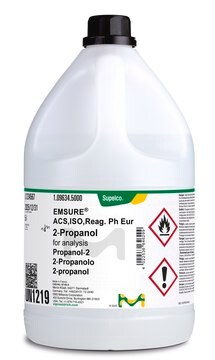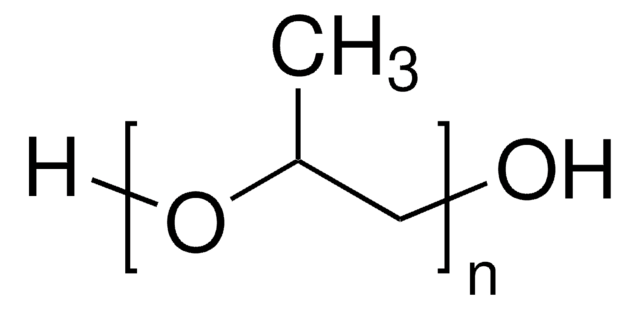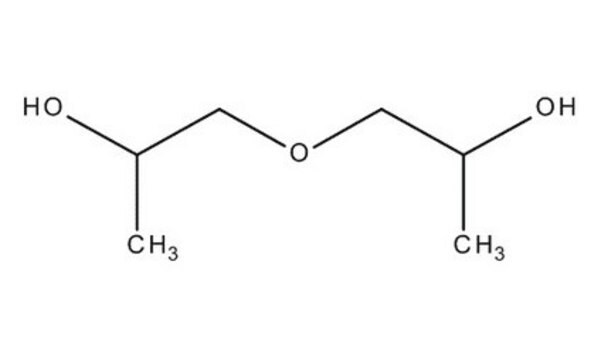W294004
1,2-propanediol
≥99.5% (GC), FCC, FG
Synonyme(s) :
Propylène glycol
About This Item
Fragrance grade
Halal
Kosher
Produits recommandés
Source biologique
synthetic
Niveau de qualité
Qualité
FG
Fragrance grade
Halal
Kosher
Agence
follows IFRA guidelines
Conformité réglementaire
EU Regulation 1223/2009
EU Regulation 1334/2008 & 178/2002
FCC
FDA 21 CFR 175.300
FDA 21 CFR 175.320
FDA 21 CFR 176.180
FDA 21 CFR 176.210
FDA 21 CFR 184.1666
Densité de vapeur
2.62 (vs air)
Pression de vapeur
0.08 mmHg ( 20 °C)
Essai
≥99.5% (GC)
Forme
viscous liquid
Température d'inflammation spontanée
779 °F
Limite d'explosivité
12.5 %
Indice de réfraction
n20/D 1.432 (lit.)
pb
187 °C (lit.)
Pf
−60 °C (lit.)
Densité
1.036 g/mL at 25 °C (lit.)
Application(s)
flavors and fragrances
Documentation
see Safety & Documentation for available documents
Allergène alimentaire
no known allergens
Allergène de parfum
no known allergens
Propriétés organoleptiques
odorless
Chaîne SMILES
CC(O)CO
InChI
1S/C3H8O2/c1-3(5)2-4/h3-5H,2H2,1H3
Clé InChI
DNIAPMSPPWPWGF-UHFFFAOYSA-N
Vous recherchez des produits similaires ? Visite Guide de comparaison des produits
Catégories apparentées
Description générale
Application
- Fatally impaired glucose digestion by propylene glycol in Aedes aegypti (Diptera: Culicidae) and co-formulation with terpenoids for enhancing attractive toxic sugar baits.: This study explores the application of propylene glycol in impairing glucose digestion in mosquitoes, offering a novel approach to vector control through enhanced toxic sugar baits. The synergy with terpenoids broadens its impact, marking significant progress in pest management strategies (Maes et al., 2024).
- Null cross-modal effects of olfactory training on visual, auditory or olfactory working memory in 6- to 9-year-old children.: This neuroscientific study utilizes propylene glycol in olfactory training exercises, investigating its potential to influence cross-modal sensory processing. Despite null findings, it provides a critical assessment of sensory integration therapies (Pieniak et al., 2024).
- Propylene glycol toxicity in an adolescent secondary to chronic cornstarch ingestion.: This medical case study addresses the risks associated with excessive propylene glycol intake, highlighting its potential toxic effects. The study serves as a crucial reminder of the need for regulatory scrutiny and public awareness regarding chemical additives in food products (Downey et al., 2024).
Code de la classe de stockage
10 - Combustible liquids
Classe de danger pour l'eau (WGK)
WGK 3
Point d'éclair (°F)
217.4 °F - closed cup
Point d'éclair (°C)
103 °C - closed cup
Équipement de protection individuelle
Eyeshields, Gloves, multi-purpose combination respirator cartridge (US)
Faites votre choix parmi les versions les plus récentes :
Déjà en possession de ce produit ?
Retrouvez la documentation relative aux produits que vous avez récemment achetés dans la Bibliothèque de documents.
Les clients ont également consulté
Notre équipe de scientifiques dispose d'une expérience dans tous les secteurs de la recherche, notamment en sciences de la vie, science des matériaux, synthèse chimique, chromatographie, analyse et dans de nombreux autres domaines..
Contacter notre Service technique




